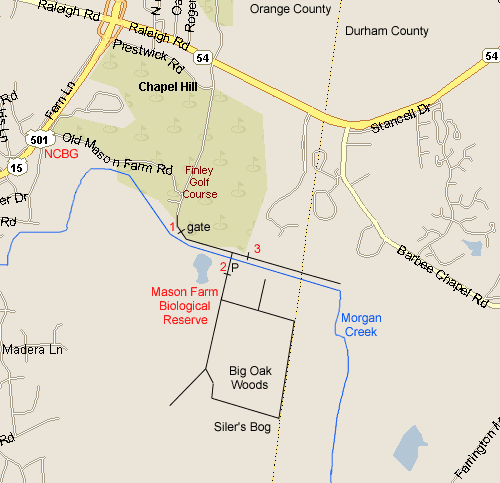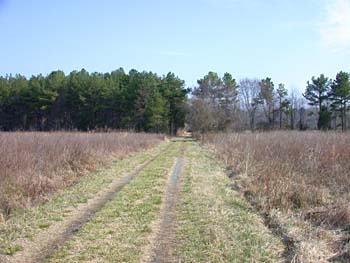
By Will Cook
Overview: Mason Farm has long been the most popular birding spot in Chapel Hill - it's loaded with birds, is an easy hike, and close to town. This 367 acre sanctuary has big open fields, extensive oak-hickory woods, and lots of great brushy areas which are overflowing with Indigo Buntings, Blue Grosbeaks, and Yellow-breasted Chats in spring and summer and with sparrows in winter. The terrain is mainly flat and the main loop is an easy hike. There's enough interesting natural history at Mason Farm that you could write a book about it. In fact, John Terres, author of the Audubon Society Encyclopedia of North American Birds, has: "From Laurel Hill to Siler's Bog: The Walking Adventures of a Naturalist" (University of North Carolina Press, Chapel Hill). Breeding bird censuses and research on avian behavior are conducted here on a regular basis. For details, visit the web site of UNC ornithologist Haven Wiley.
 |
Key birds: Spring and Summer: Acadian Flycatcher, Northern Parula, American Redstart, Prothonotary Warbler, Common Yellowthroat, Yellow-breasted Chat, Blue Grosbeak, Indigo Bunting, Orchard Oriole
Winter: Wilson's Snipe, American Woodcock, Fox Sparrow, Swamp Sparrow, White-throated Sparrow, Rusty Blackbird, Purple Finch
Year-round: woodpeckers, Pine Warbler, Eastern Towhee
Getting there: Technically you are supposed to get an annual permit from the North Carolina Botanical Garden before visiting, but this has not been enforced in many years. Ask at the Education Center of the North Carolina Botanical Garden if you want to be sure what the policy is. To get to Mason Farm from Durham, take 15-501 south through Chapel Hill. After the 54 intersection and before Manning Drive, turn left on Old Mason Farm Road (look for brown NC Botanical Garden sign). If you want to ask about a permit, turn right into the NCBG parking lot, otherwise continue on this road till you see Finley Golf Course. Just before the road makes a sharp turn to the left, turn right into what looks like a parking lot behind the building at the corner. Follow the edge of the parking lot and turn right when you get to the practice green. In a short distance bear right again (just past the little cemetery) and you'll see the gate (always open in recent years) that marks the entrance to Mason Farm, with a dirt road going through the woods beyond.
Coordinates: 35.895202, -79.021995
What to look for: Sparrows in winter, warblers in spring and fall, hawks all year. Loaded with birds associated with brushy areas, particularly Indigo Buntings, Blue Grosbeaks, and Yellow-breasted Chats. Reliable spot for Kentucky Warblers, which nest here. There are more records of Lincoln's Sparrow and Olive-sided Flycatcher here than anywhere else in the area. Swainson's Warblers used to nest here and may return someday. One of the best all-around birding spots in the Triangle.
Where to go:
1. Hackberry-Warbler Trail: [Note: this trail has not been maintained in years, left here only so you know what the 1. on the map means] Pull off on the right before you get to the entrance gate and you'll see a little trail leading down to Morgan Creek. Note: this trail has not been maintained in many years, but you can still bushwhack. The former loop trail traverses the low woods beside the creek, through stands of big Sugarberry trees (Celtis laevigata), which are a kind of hackberry. These trees can be good for warblers in spring and the understory of Chinese Privet (Ligustrum sinense) and other exotic invasive plants is loaded with White-throated Sparrows in winter. Trail length is less than a mile. If time is limited, skip this part.

2. Big Oak Woods Trail: This is the main section of the reserve. Drive past the gate (which has been open for years) down a narrow gravel road and look for the beaver pond on the left. You can easily park a little further on and walk back to the pond. Unfortunately the golf course management periodically destroys the beaver pond, so there may or may not be a pond. Further on, look for the concrete ford crossing Morgan Creek on the right. Turn right, drive over the ford, and park on the other side in the parking area. The ford may be impassible after heavy rain - check the Morgan Creek gauge height for the latest conditions. Do not cross above the 5-ft level; never cross if you are at all uncertain.
The parking area is often loaded with birds - check it out carefully. Continue on foot past the gate, sign the guest register, and check the sightings log. The main trail is a level gravel road, which takes you past weedy fields and thickets on the left and low woods on the right. Both sides of the trail abound with birds. When you get to the fork in the road, turn left (or continue straight if you wish to follow the loop counterclockwise).
The trail continues through brushy areas between fields (loaded with hundreds of White-throated Sparrows in winter), with a ditch on the left that is usually filled with water. The large number of birds here makes it very slow going. King Rails bred here in 1996 and Nothern Waterthrushes often stop by during migration. Good numbers of Fox Sparrows are here in winter. To the left is a short side road that goes straight between fields to the creek. It's usually well worth exploring if you have time. If you turn left from the side road and follow the straight row of planted trees (no trail) to the left, you'll get back to the parking lot. This area is outstanding for seeing the twilight aerial displays of American Woodcock in January and February. During the day, keep an eye on the sky for soaring birds. Red-shouldered, Red-tailed Hawks, and Turkey Vultures are common, Black Vultures fairly common, Bald Eagles are rare.
Continue on the main trail and follow it as it turns to the right. This takes you past a large open field on the left and a brushy border on the right, usually packed with birds. The trail enters the low forest of tall hardwoods. On the left is a semi-open area and on the right mature forest, called the Big Oak Woods. The woods on the right are home to Kentucky Warblers - carefully listen for their song, which is distictive but can easily be confused with a Carolina Wren's. This is one of the most reliable spots in the Triangle for Kentucky, but they are still easy to miss. The easiest way to see one is to track down a singing male - look for him sitting about 20 feet up on a horizontal limb of a tree. In addition to oaks, the Big Oak Woods have a large number of mature Carolina Shagbark Hickories (Carya carolinae-septentrionalis), an uncommon species that is easily told from regular shagbark by its thin blackish twigs - Shagbark Hickories (Carya ovata) have stout gray twigs.
The trail takes another sharp bend to the right and enters a swampy area, known as Siler's Bog. The wet field on the left is great for sparrows, especially Swamp Sparrows, and the dead trees on the right formerly hosted good numbers of Red-headed Woodpeckers. Check the tips of the dead trees for Olive-sided Flycatchers in migration.
After leaving the swampy area, you continue past areas of field and forest, which usually harbor smaller numbers of the birds you've already seen, except for Eastern Bluebirds, which are more plentiful on this side thanks to the bluebird houses. About halfway though the back section of the loop a trail off to the left goes up into some drier woods. This one-way trail eventually leaves the reserve, but is worth exploring for a short distance for species such as Ovenbird and Hooded Warbler that are rarely found along the main loop. There are many large Carolina Shagbark Hickories off this trail, including the state champion.
Continue straight on the main trail and you'll complete the loop. Total length of this loop is about two miles.
3. Field north of Morgan Creek: Park near the concrete ford on the north side of Morgan Creek but instead of crossing, continue straight (east) on foot to the end of the road and past a gate. Follow the gravel trail, with field on left and thicket/forest on right until it dead ends at a swamp, known as Willow Oak Swamp, then retrace your steps. One-way distance is about a mile. The field is great for sparrows in winter and has Orchard Oriole in spring. Common Yellowthroat and Orange-crowned Warbler sometimes winter here. The adjacent trees are good for nesting American Redstart and Prothonotary Warbler, and migrants in spring. Near the swamp look for N. Rough-winged Swallow and Green Heron in the nesting season.
When to visit: Spring, fall, and winter are excellent. In summer there is still plenty to see, but deerflies tend to be much more abundant than birds.
Facilities: None, but restrooms and drinks are available at the Education Center. Dogs are not allowed in the reserve.
Links: For a little more information, see the official Mason Farm page.
Triangle Birder's Guide home | Chatham/Jordan Lake | Durham/Falls Lake | Orange | Wake